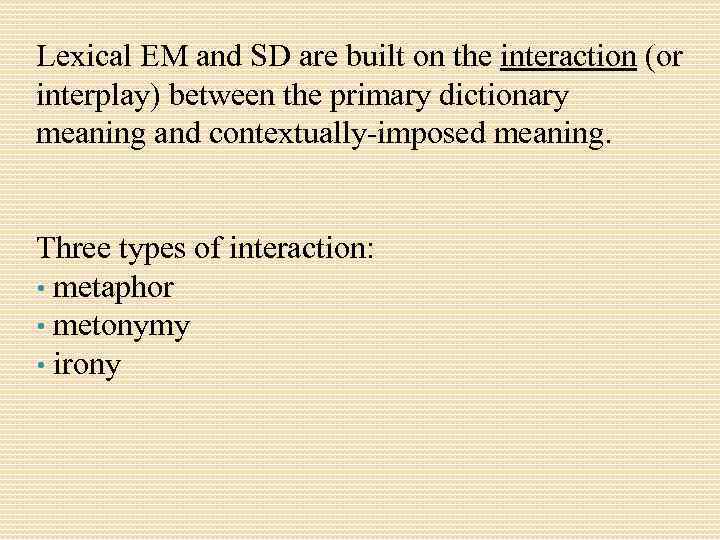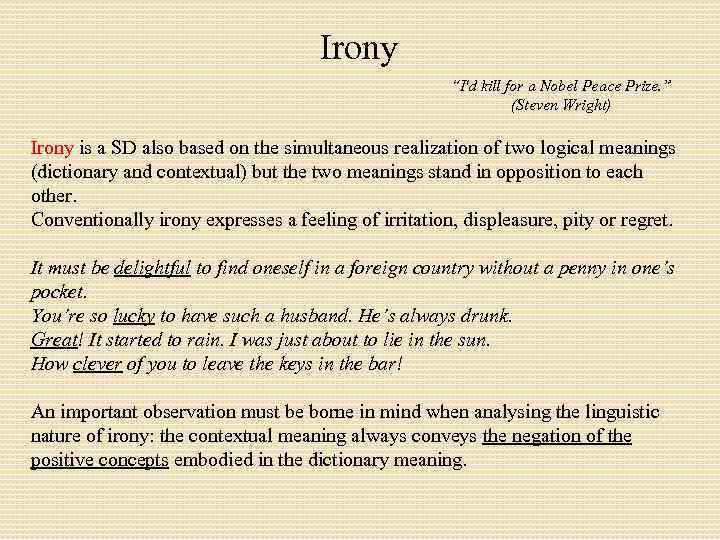Презент Lexical SD.pptx
- Количество слайдов: 8
 LEXICAL EXPRESSIVE MEANS AND STYLISTIC DEVICES Презентацию подготовил: Поляков А. , ЭЛП-411
LEXICAL EXPRESSIVE MEANS AND STYLISTIC DEVICES Презентацию подготовил: Поляков А. , ЭЛП-411
 Lexical EM and SD are built on the interaction (or interplay) between the primary dictionary meaning and contextually-imposed meaning. Three types of interaction: • metaphor • metonymy • irony
Lexical EM and SD are built on the interaction (or interplay) between the primary dictionary meaning and contextually-imposed meaning. Three types of interaction: • metaphor • metonymy • irony
 Metaphor “The metaphor is perhaps one of man's most fruitful potentialities. Its efficacy verges on magic, and it seems a tool for creation which God forgot inside one of His creatures when he made him. ” (José Ortega y Gasset) Metaphor means transference of some quality from one object to another. It occurs when the author identifies two objects which have nothing in common, but in which he subjectively sees a function/a property/a feature/a quality that may make the reader perceive these two objects as identical: • Iron Chancellor, clock hands, table legs, head of the rail – common function • You’re my sunshine; He’s such a kitten when he sleeps – common appearance
Metaphor “The metaphor is perhaps one of man's most fruitful potentialities. Its efficacy verges on magic, and it seems a tool for creation which God forgot inside one of His creatures when he made him. ” (José Ortega y Gasset) Metaphor means transference of some quality from one object to another. It occurs when the author identifies two objects which have nothing in common, but in which he subjectively sees a function/a property/a feature/a quality that may make the reader perceive these two objects as identical: • Iron Chancellor, clock hands, table legs, head of the rail – common function • You’re my sunshine; He’s such a kitten when he sleeps – common appearance
 According to the degree of unexpectedness metaphors can be classified into: genuine metaphors (absolutely unexpected): the copper leaves fell sorrowfully; scarlet wings of dusk, silk eyelashes, chromosome bridge, the sky lamp of the night (the moon), “The alchemy of finance”; • trite (dead) metaphors (commonly used in speech and sometimes even fixed in dictionaries): a ray of hope, a flight of fancy, time is money, golden heart, black Friday, happy hour, to fall from power, better half. •
According to the degree of unexpectedness metaphors can be classified into: genuine metaphors (absolutely unexpected): the copper leaves fell sorrowfully; scarlet wings of dusk, silk eyelashes, chromosome bridge, the sky lamp of the night (the moon), “The alchemy of finance”; • trite (dead) metaphors (commonly used in speech and sometimes even fixed in dictionaries): a ray of hope, a flight of fancy, time is money, golden heart, black Friday, happy hour, to fall from power, better half. •
 Metonymy “Two daiquiris withdrew into a corner of a gorgeous room and one told the other a lie. ” (John Berryman) Metonymy is a SD based on some kind of association connecting the two concepts which the dictionary and contextual meanings represent. Metonymic meanings are derivative logical meanings and therefore fixed in dictionaries. When such meanings are included in dictionaries they do not replace the primary one, but co-exists with it. It must also be noted that metonymy generally concerns concrete objects which are generalized. The process of generalization is easily carried out with the help of the definite article. Therefore instances of metonymy are very often used with the definite article, or with no article at all.
Metonymy “Two daiquiris withdrew into a corner of a gorgeous room and one told the other a lie. ” (John Berryman) Metonymy is a SD based on some kind of association connecting the two concepts which the dictionary and contextual meanings represent. Metonymic meanings are derivative logical meanings and therefore fixed in dictionaries. When such meanings are included in dictionaries they do not replace the primary one, but co-exists with it. It must also be noted that metonymy generally concerns concrete objects which are generalized. The process of generalization is easily carried out with the help of the definite article. Therefore instances of metonymy are very often used with the definite article, or with no article at all.
 Cases of metonymy depending on the types of relations: • a concrete thing used instead of an abstract notion: a sword cannot solve all the problems, let me give you a hand, lend me your ears, crown (a king/ a queen), the grave (the death); • the container instead of the thing contained: The hall applauded; He ate two plates; The furnace was crackling in the silent winter cabin; • the material instead of the thing mad of it: He collects china; Last year he won the silver; There are dancing on marble. She was presented with amber; the instrument which the doer uses in performing the action instead of the action or the doer himself: Pushkin was a wonderful pen; This violin is a pride of the orchestra; His pipe lured the rats into the river where all of them drowned; • the relation of proximity: The flat was noisy and cheerful; The classroom was shocked; The town was celebrating the festival. •
Cases of metonymy depending on the types of relations: • a concrete thing used instead of an abstract notion: a sword cannot solve all the problems, let me give you a hand, lend me your ears, crown (a king/ a queen), the grave (the death); • the container instead of the thing contained: The hall applauded; He ate two plates; The furnace was crackling in the silent winter cabin; • the material instead of the thing mad of it: He collects china; Last year he won the silver; There are dancing on marble. She was presented with amber; the instrument which the doer uses in performing the action instead of the action or the doer himself: Pushkin was a wonderful pen; This violin is a pride of the orchestra; His pipe lured the rats into the river where all of them drowned; • the relation of proximity: The flat was noisy and cheerful; The classroom was shocked; The town was celebrating the festival. •
 Irony “I'd kill for a Nobel Peace Prize. ” (Steven Wright) Irony is a SD also based on the simultaneous realization of two logical meanings (dictionary and contextual) but the two meanings stand in opposition to each other. Conventionally irony expresses a feeling of irritation, displeasure, pity or regret. It must be delightful to find oneself in a foreign country without a penny in one’s pocket. You’re so lucky to have such a husband. He’s always drunk. Great! It started to rain. I was just about to lie in the sun. How clever of you to leave the keys in the bar! An important observation must be borne in mind when analysing the linguistic nature of irony: the contextual meaning always conveys the negation of the positive concepts embodied in the dictionary meaning.
Irony “I'd kill for a Nobel Peace Prize. ” (Steven Wright) Irony is a SD also based on the simultaneous realization of two logical meanings (dictionary and contextual) but the two meanings stand in opposition to each other. Conventionally irony expresses a feeling of irritation, displeasure, pity or regret. It must be delightful to find oneself in a foreign country without a penny in one’s pocket. You’re so lucky to have such a husband. He’s always drunk. Great! It started to rain. I was just about to lie in the sun. How clever of you to leave the keys in the bar! An important observation must be borne in mind when analysing the linguistic nature of irony: the contextual meaning always conveys the negation of the positive concepts embodied in the dictionary meaning.
 THANK YOU!
THANK YOU!


